


Sapphires, rubies, pearls and diamonds: to Sir Hugh Keating, English aristocrat and Govan town deputy, the jewellery is the dowry for his future wife. To Black Elliot and his gang however, the jewellery means money and prestige. So, when the gems are stolen, it means a lot of trouble for Sheriff Darrow.
Somehow he must prevent the jewellery from being smuggled out of Govan and he and his men are stretched to their limits as they guard the trails and search the town. Meanwhile, Black Elliot must stay one junp ahead of the law as he fights to keep his men under control.
Darrow's right to wear his badge is under threat and as time runs out for both men, the battle of wits will finish in a cloud of gunsmoke.
So, where to go next with Darrow and Hugh ? I had plenty of ideas for them, it was a matter of choosing some of them and tying them into a novel. I was thinking about Hugh getting married to Minnie, and the social differences between them. In the first books, Minnie's clothes are mostly home-made and unfashionable. She lives at home with her parent's, washing, shopping, baking and helping raise her younger brothers. While she seems an obvious choice to Hugh, who has been living in Govan for about four years, his aristocratic family might see things differently.
I talked about this to a friend, Sarah. What would Hugh's older brother, Richard, make of Minnie and Govan ? How would Minnie feel when presented with the heirloom jewellery that was her dowry from Hugh's family ? More practically, how to turn these social questions into a Black Horse Western ? Sarah asked a question in return; a simple question, but one which gave me the key to the story.
So, having settled on a storyline with a theft, I needed to create the thieves. Black Elliot is the leader of the gang, a dandy-dressed half-caste who's a bit of a control freak. I started the book with Hugh and Darrow meeting before their inspection of the carnival. When revising, I wanted to get the bad guys into the story earlier, and by that time, I had a better idea of who Black Elliot was and what made him tick. I wrote a new opening, which had Black Elliot watching Darrow as he left the office and went to meet Hugh. It gave me a chance to have a third-party description of Darrow, and to build up Elliot's automatic dislike of him as a white Southern aristocrat. It gave a more personal edge to the battle of wits between sheriff and thief.
For me to keep the action in Govan after the jewellery theft, it was necessary for Darrow to seal off the town and stop the bad guys from leaving. It was also necessary for Black Elliot to co-operate by going into hiding until I could have the good guys solve the puzzle and catch or kill the bad guys. My solution was to make Black Elliot inflexible: once he had settled on a plan, he would stick to it as closely as possible. He'd been smart enough to plan a successful robbery, only scuppered by the non-arrival of a train, which was out of his control. Elliot had to be smart enough to avoid the law until the last chapter, but needed a weakness so he could be caught in the end. (Juggling characters like this can do bad things to your head. No wonder so many writers take to drink.) Elliot also had the disadvantage of trying to keep control of the rest of his gang, just as Darrow had to manage his helpers. Darrow and his men trying to catch the thieves by a certain date, became a parallel story to Elliot and his men trying to escape the town, under pressure of time.
The rest of Black Elliot's gang are Curly Joe, Tomcat Billy and Irish. The name Curly Joe came from out of thin air. I sketched him in as a vain part-Mexican who liked to play up his Hispanic ancestry, including his hot-blooded temper. I never liked Curly Joe much, but that was just as well. I could use him as the least reasonable voice in the bad guys; the one who urged Elliot into reckless actions, and who provided the most conflict within the group. And at the end, I could happily kill him off !
Tomcat Billy and Irish were different. I got very fond of them, and indeed used Tomcat as a rolepaying character in a campaign. I think that one of the things I like about Tomcat is that he's essentially an uncomplicated person, with a knack for living in the moment and being content. He finds ways of simply enjoying life, which makes a nice change from other, more demanding characters. Tomcat is my first hill-billy character, and my research went into whether the phrase hill-billy had been in use at that time. I had an enjoyable time reading about Tomcat's use of language, and picking up a few hill-billy jokes along the way.Tomcat's life came to me easily and he became part of a large family. Although he tells Darrow he was born twelth, it's part of a joke. Tomcat was actually number eleven. His mother intended to stop at twelve, but number twelve turned out to be twins, which made an unlucky total of thirteen children. So his ma had one more, to make the numbers up to fourteen. Tomcat's nickname was originally to do with his superb climbing and jumping skills, inspired by the feats of Asian actors in martial arts movies. I wanted Tomcat to be able to almost fly up walls, as Jackie Chan does. As the story developed, I found that Tomcat also applies to his attitude towards women. He seems to have the sexual confidence of a healthy tomcat. I have no idea what Tomcat Billy's actual name is. I assume Billy is his first name, but I'm not sure. Maybe I'll figure it out sometime. It doesn't really matter. Tomcat Billy suits him perfectly.
Irish is Tomcat's physical opposite; he's tall, heavy and somewhat reminisent of an ox. The friend he was modelled after shares his looks, but is a whole lot smarter.

Both Tomcat and Irish are semi-literate. Irish is willing to let the faster-moving and faster-thinking Tomcat take the lead in most of their activities. He's by no means stupid though, and his common sense is a useful foil to Tomcat's more impulsive behaviour. As I wrote the characters, I saw that Tomcat and Irish were good friends, loyal to one another, and that their freindship goes back further than their acquaintance with Black Elliot and Curly Joe. I put in a bit of back story about Tomcat almost dying from a rattlesnake bite, two years earlier. Although it isn't in the final book, it was Irish who saved Tomcat's life then. As I wrote and lived with the characters, I realized something else about Irish. There is just a hint in the book that he may have some kind of psychic power. He remarks to Curly Joe and Elliot that Tomcat won't get buried in this town's graveyard, speaking in a way that suggests someone else present will. He turns out to be correct.
In 2002 and 2003 I visited Blackpool, once with family and once with a friend. Both times I visited both the Pleasure Beach and the tower, with its circus (all highly recommended). I began thinking about including some kind of circus or carnival in a western. I remembered seeing carnivals in western movies, like Ride the High Country and My Name is Nobody. Now, Hugh has already shown his ability as a juggler, card-sharp and lock-pick. It seemed logical that he could have made the acquaintance of the circus and fairground people who visited his family's village every year, and learned something from them.
I started researching circuses and fairs of the period. My internet search wasn't very helpful, as most on-line references were about the twentieth century, or about English fairgrounds. I did find references to the National Fairground Archive. Most conveniently, this is based in Sheffield University Library, which about about five minutes walk from my home. Even better, the curator is Vanessa Toulmin, an acquaintance of mine from the time we were both studying archaeology at the Univerity. I visited the Archive, and spent a happy couple of days there, finding out far more than I really needed to know. Their website is at the National Fairground Archive
The traditional travelling circus wasn't established in America in the 1870's, when my story was set, so that narrowed down my choice. Vanessa found a small booklet for me which became invaluable. I learned how the early American carnivals differed from the English shows of the same period. Not only did the stalls have different names, but the American ones were much simpler than the elaborately carved and painted stalls that were common in Britain.

I also learned a fascinating amount on how stalls could be rigged in favour of the stall holder. This gave me a way of making the carnival relevent to Darrow and Hugh. The first time we meet them in the book, they are inspecting the newly-arrived carnival. Hugh gets to point out the differences between the English and American styles, and also gets to show off both his skills on the stalls, and his knowledge of how to rig them. While checking the carnival, they get the better of one of the stall-holders, a J Archer. When he is outwitted, and fails to either bribe them, or bluff them, Archer's temper turns very nasty. Any resemblance between the stall-holder, J Archer, and a disgraced politician/novelist, may or may not be a coincidence.
This new book is set two years after the first was written. Western towns could grown remarkably fast, and I felt that my map of Govan needed redrawing. The town was originally built around two main roads, north of the railroad line and east of a small river. It's now grown another major commerical street running parallel with the southern part of Main Street and another, smaller, commercial street running northwards. On a rise to the north of town are two streets of larger, upmarket houses, intended to be suitable for the prosperous businessmen that Govan expects to have.
It's one of these new houses that Hugh and Minnie will live in after their marriage. I found a plan of the right kind of house in one of Time-Life's books on 'The Old West'. It reproduces plans from a mail-order catalogue of 1870, which offered kits for all kinds of buildings from single room dwellings, to large family houses, schools and churches.
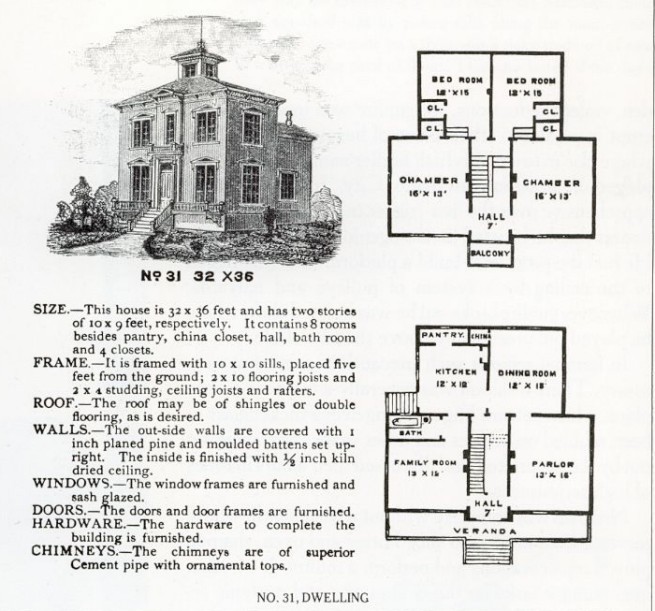
To buy this building, including the hardware to complete the house, in 1870, would cost $3,500. A functional three-room house could be had for only $600.
As well as new housing, Govan also has new civic buildings. There's a separate High School now, a Civic Hall, for dances, meetings and lectures etc, and a theatre, which hosts both professional and amateur shows. Josh Turnage, the undertaker who helps out the lawmen occasionally, has joined the Amateur Players Society, and proven himself a natural in the role of villian. He has a reason beyond a simple love of theatre:
"A lonely undertaker's got to find something to do in the evenings." Turnage answered. "I want to try and meet some women who are still breathing. Trouble is, most of them aren't too keen on a husband that's got dead folk in the shop downstairs."
Having killed off the town's saddlemaker in the last book, I made his shop into a drug store, and put a new saddlemaker on another street. Govan's growing population can now boast a dentist, a photographer, a music teacher, a waggon maker, a tobacconist and a jeweller, all of whom can advertize in the town newspaper, the Govan Herald. I don't think the town will grow noticably in the immediate future; not least, because I'd need a much bigger piece of paper to draw the map on.
It occurred to me that if Govan had grown so much, it was getting to be more than Darrow and Hugh could realistically police on their own. More so, as Darrow is actually sheriff of the surrounding county, and not just the town marshal, although he effectively fills both posts. (Since making him a sheriff, I've since learned more about the technicalities of western law enforcement of the era). With Hugh away on an extended honeymoon in Europe, it was logical to bring in another lawman. I was somewhat reluctant to do so, as the dynamic between Darrow and Hugh worked so well, but I had already found that they needed to rope in other townfolk to help them anyway, and they couldn't realistically keep borrowing the town undertaker whenever they got outgunned. As I had drawn Darrow and Hugh from Blakes 7, so I drew on the series for the new deputy.
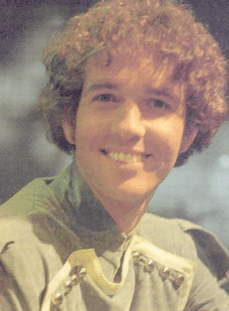
I brought in Tom Pacey, named for Steven Pacey, the actor who played Del Tarrent in Blakes 7. Like Steven, Deputy Pacey is tall, athletic and handsome, with blue eyes and a wonderful, bright smile. Like the character, Tarrant, Deputy Pacey is inclined to be impulsive, self-assured, a bit of a ladies' man, and handy in a fight. He first appears when coming to rescue Hugh and his brother, Richard, from a fight with a wagon-driver. Hugh is not grateful for being shown up by the newcomer:
Hugh scrambled to his feet, brushing at his clothes, and glowered at the new deputy. Pacey was ten years younger than himself, over six feet tall, well-built and handsome, with curly brown hair and blue eyes. He had served as a lieutenant in the cavalry, after graduating from a distinguished military college in New England. Finding Army life too restrictive, he had decided to try law work. Pacey was a good horseman, a good shot, a good fighter, brave, and popular with women. Hugh had disliked him immediately.
Hugh's feelings about Pacey are in the minority, for Richard is more impressed with Pacey.
"He makes an excellent figure of a man." Richard agreed with his wife.
Hugh's opinion that such an excellent figure of a man should be stuffed and used to display clothes, was fortunately silenced by Minnie returning his gun, and asking anxiously how he was.
Hugh and Pacey do find a common interest in the more worldly pleasures available in Govan, the sort that the sheriff has no interest in. This first move towards friendship recieves an immediate setback when Pacey promptly rushes them both headlong into trouble. Hugh may not be keen on Pacey's attitude, but impulsive characters are appreciated by authors - it's so much easier to get them into trouble !
Darrow's Badge' took some time to write. Poor health and a major refurbishment of my flat both got in the way, and I found it difficult to get back into a daily routine. Work ground to a halt for some time half way through, before I got back on track in early 2004. I wanted the book finished and accepted before attending the Star One Convention (Blakes 7) in April. Both Paul Darrow and Michael Keating were guests there, and I wanted to tell Paul, in particular, about the new book.If you want an idea of what Sheriff Darrow and Deputy Hugh might look like some two decades on from the adventures I've written so far, here are a couple of photos:
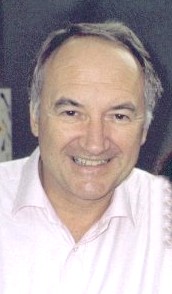
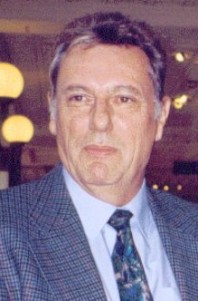
That's Michael Keating on the left, and Paul Darrow on the right. Both photos were taken in 2003. Sheriff Darrow isn't often seen suppressing a grin, like Paul is here, but then Sheriff Darrow doesn't have Paul's sense of humour. This is probably a Good Thing, or at least would result in a rather different series of books.
To get back to the book, when I finished writing I realised that oweing to a technical hiccup, I'd written most of it in a 10 point font, not the size 12 font I prefer. I'd been basing my word count on a size 12 font, like last time. As I'd actually got more words to the page, my book was now much longer than I'd thought. Although I was pleased with it, I had to sit down and plough through it all again, cutting chunks out to bring it back down to length. Most of what went was character stuff, entertaining but generally not essential to the plot. There was some lovely stuff I regret losing though. There was also a complete scene where Irish intervenes when a father unfairly whips his son. It was a nice piece of action, which drew the attention of Darrow and Pacey, and showed the new deputy's tendancy to act first and think later. There was another scene of Black Elliott and Curley Joe passing the time by gambling with some cowboys and one of the regular minor town characters. Curley's temper starts to get the better of him when he loses and Elliot has to work hard to keep the situation under control. It showed the pressure that the outlaws were under, especially their leader.I'm a great believer in recycling, so the good stuff may show up again in other books, modified as necessary.
I was delighted when the book was accepted, though there was a comment from John Hale on the small size of the font. Copy-editing the manuscript took longer than usual though. For one thing, the hyphen-monster had been at my work again, scattering them about like confetti. I slashed away at them ruthlessly and managed to get most of the excess removed. More awkwardly, it turned out that in spite of my best intentions, I had been inconsistent in my spelling of 'Elliot'. It was sometimes spelled with two 't's (the version I preferred), and sometimes with one. This wasn't really noticed until the page proofs stage, where corrections can be costly. To add an extra 't' in all the places it was missing, would have meant rearranging a lot of text. It was easier and cheaper to change to the single 't' spelling.
Another hiccup that the editor picked up on was a continuity error near the end. There was an inconsistancy about exactly who had locked Tomcat in the cell, which had to be sorted out with as little rewriting as possible. I also had to do some research and thinking about Hugh's family. I had originally written his brother, Richard, and wife, as Sir Richard and Lady Louisa. These titles would put them rather higher up the social scale than I envisaged. I settled on making Hugh and Richard's father a baronet, which would give him the title 'Sir'. As the oldest son, Richard would most likely be referred to as 'Sir Richard' in the local community, but as a courtesy. It also adds weight to the running joke about Hugh not liking to be addressed as 'Lord'. I don't think that it's the error of etiquette that annoys him. It's more likely that he was bullied at school, or otherwise suffered, for being landed gentry and not 'true' aristocracy.
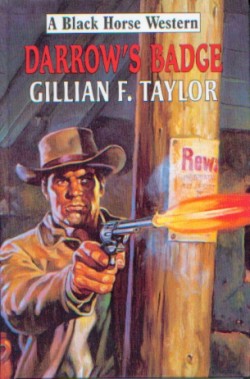
As with the previous title, the blurb is almost unchanged from the version I submitted. The cover is similar to that of Darrow's Word, being a night-time close-up of a man with a revolver standing close to some wooden architecteral feature. This time, the guy on the cover is firing his gun, producing a muzzle flash worthy of a small flamethrower. I think that with a little less muzzle flash, I'd have really liked it, even though it doesn't really depict anything in particular from the book. Nothing new there then....
The large-print edition was published August 2006.

Back to Black Horse Western page
Back to my home page